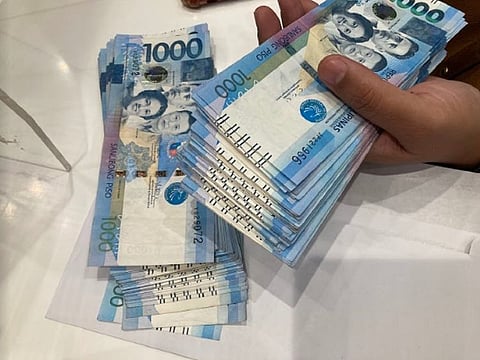Philippine peso at 57.47 vs $1, will it rise with rate easing?
Average exchange rate in 2024 covering 136 days is 56.3657 vs $1

Manila: The Philippine peso ended Wednesday slightly higher at 57.634 to the US dollar, from Tuesday’s close of 57.851, according to central bank data.
The peso opened stronger at 57.35, compared to the previous day's opening of 57.71.
Since the start of 2024, the peso has lost ground from 55.40 on January 1, to 57.71 on May 1 and 57.634 on May 16 – equivalent to 4.28 per cent drop in value, based on data from Exchange Rates UK.
The average exchange rate in 2024 covering 136 days is 56.3657 vs $1, with the worst exchange rate at 55.3282 on March 11, 2024, and the best rate was 57.8867 on April 24, 2024.
Policy rate easing seen
Meanwhile, the Bangko Sentral ng Pilipinas (BSP) is expected to ease policy rates starting August this year, based on latest comments from the its governor.
On Thursday, May 16, the BSP’s Monetary Board decided to keep policy rates unchanged for the fifth consecutive meeting, maintaining a policy pause that has been in place since November 2023.
The BSP kept its benchmark overnight reverse repurchase rate unchanged at 6.50 per cent, with the interest rates on overnight deposit and lending facilities steady at 6 percent and 7 percent, respectively.
“We are actually somewhat less hawkish than before, which means we could ease or cut rates Q3 (third quarter) or Q4 (fourth quarter) this year, so the second half of this year,” BSP Governor Eli Remolona Jr. said in a rcent briefing.
The Monetary Board is scheduled to hold its next meeting in August.
“Yes. Possibly by August this year,” Remolona said when asked about the timeline of the possible easing.
“As you know, there was a good number in April, 3.8 percent [inflation]. That was mainly driven by rice inflation. But also, 3.8 percent was better than expected. Actually, it's better than it looks because that included some positive base effects. It's actually better, and then there were other factors for good news in terms inflation,” he added.
The USD/PHP prediction from algorithm-based forecaster Wallet Investor forecast that the peso could strengthen this year.
"The BSP's latest forecasts indicate that inflation would settle close to the upper end of the [2 to 4 percent] target range," said BSP Governor Remolona.
In Makati City, Remolona mentioned to reporters that the BSP might cut rates twice in the second half of the year, totaling 50 basis points.
Central banks use monetary policy to manage economic fluctuations and achieve price stability, to keep inflation in check, i.e. low and stable. In most economies, central banks set explicit inflation targets, while many developing countries including the Philippines also are moving to inflation targeting.
Stocks gain
The Philippine Stock Exchange index (PSEi) gained on Thursday, buoyed by improvements on Wall Street and anticipation of the Monetary Board's policy decision.
Despite the peso closing relatively sideways, the PSEi rose by 1.06 percent to close at 6,628.20. The All Shares index also saw an uptick, closing 0.72 percent higher at 3,524.52 points compared to Wednesday’s close.
Sign up for the Daily Briefing
Get the latest news and updates straight to your inbox



